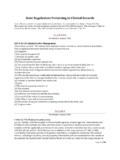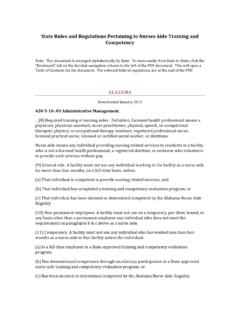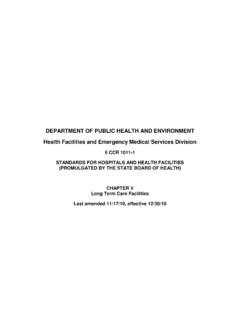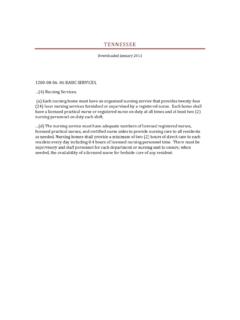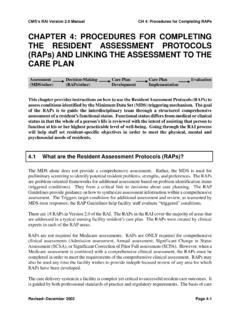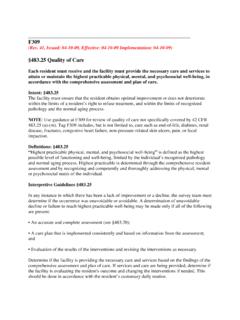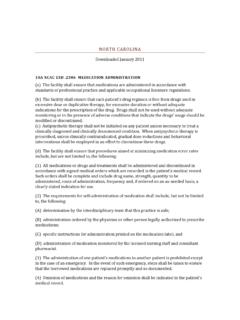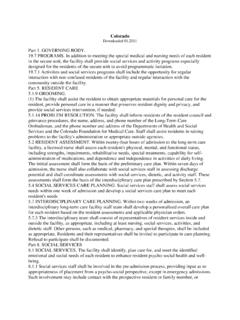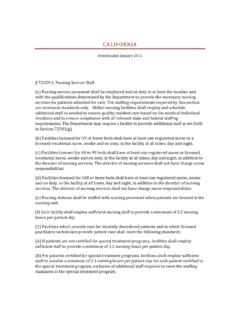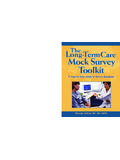Transcription of State Regulations Pertaining to Admission, …
1 Page 1 of 191 St ate Regulations Pertaining to admission , transfer , and Discharge Rights Note: This document is arranged alphabetically by State . To move easily from State to State , click the Bookmark tab on the Acrobat navigation column to the left of the PDF document. This will open a Table of Contents for the document. The relevant federal Regulations are at the end of the PDF. ALABAMA Downloaded January 2011 Resident Rights..(3) Notice of rights and services..(e) The facility must: 1. Inform each resident who is entitled to Medicaid benefits, in writing, at the time of admission to the nursing facility or, when the resident becomes eligible for Medicaid of: (i) The items and services that are included in nursing facility services under the State plan for which the resident may not be charged. (ii) Those other items and services that the facility offers and for which the resident may be charged, and the amount of charges for those services; and 2.
2 Inform each resident when changes are made to the items and services specified in paragraphs (e)1(i) & (ii) above. (f) The facility must inform each resident before, or at the time of admission , and periodically during the resident's stay, of services available in the facility and of charges for those services, including any charges for services not covered under Medicare or by the facility's per diem rate. (g) The facility must furnish a written description of legal rights which includes: .. description of the requirements and procedures for establishing eligibility for Medicaid, including the right to request an assessment by the State Medicaid Agency to determine the extent of a couple's non-exempt resources at the time of institutionalization and attributes to the community spouse an equitable share of resources which cannot be considered available for payment toward the cost of the institutionalized spouse's medical care in his or her process of spending down to Medicaid eligibility levels.
3 (j) The facility must prominently display, in the facility, written information, and provide to residents and applicants for admission , oral and written information about how to apply for and use Medicare and Medicaid benefits, and how to receive refunds for previous payments covered by such benefits..(k) Notification of changes. A facility must immediately inform the resident; consult with the resident's physician; and if known, notify the resident's legal representative or an interested family member when there is: ..4. A decision to transfer or discharge the resident from the facility as specified in Section Page 2 of 191 admission , transfer , Transport and Discharge Rights. (1) Admissions, transfers, transport and discharge. (a) transfer and discharge includes movement of a resident to a bed outside of the certified facility whether that bed is in the same physical plant or not.
4 transfer and discharge does not refer to movement of a resident to a bed within the same certified facility. (b)The facility must permit each resident to remain in the facility, and not transfer or discharge the resident from the facility unless: 1. The transfer or discharge is necessary for the resident's welfare and the resident's needs cannot be met in the facility; 2. The transfer or discharge is appropriate because the resident's health has improved sufficiently so the resident no longer needs the services provided by the facility; 3. The safety of individuals in the facility is endangered; 4. The health of individuals in the facility would otherwise be endangered; 5. The resident has failed, after reasonable and appropriate notice, to pay for (or to have paid under Medicare or Medicaid) a stay at the facility. For a resident who becomes eligible for Medicaid after admission to a nursing facility, the nursing facility may charge a resident only allowable charges under Medicaid; or 6.
5 The facility ceases to operate. (c) Documentation. When the facility transfers or discharges a resident under any of the circumstances specified in this section, the resident's clinical record must be documented. The documentation must be made by: 1. The resident's physician when transfer or discharge is necessary under paragraph (1) (b) 1 or paragraph (1) (b) 2 of this section; and 2. A physician when transfer or discharge is necessary under paragraph (1) (b) 4 of this section. (d )Notice before transfer . Before a facility transfers or discharges a resident, the facility must: 1. Notify the resident and, if known, a family member or legal representative of the resident of the transfer or discharge and the reasons for the move in writing and in a language and manner they understand. 2. Record the reasons in the resident's clinical record; and 3. Include in the notice the items described in paragraph (f) of this section.
6 (e) Timing of the notice. Except when specified in paragraph (e)1 of this section, the notice of transfer or discharge required under paragraph (d)1 of this section must be made by the facility at least 30 days before the resident is transferred or discharged. 1. Notice may be made as soon as practicable before transfer or discharge when: (i). The safety of individuals in the facility would be endangered, under paragraph (1)(b)3 of this section (ii) The health of individuals in the facility would be endangered, under (1)(b)4 of this section. (iii) The resident's health improves sufficiently to allow a more immediate transfer or discharge, under paragraph (1)(b)2 of this section; Page 3 of 191 (iv) An immediate transfer or discharge is required by the resident's urgent medical needs, under paragraph (1)(b)1 of this section; or (v) A resident has not resided in the facility for 30 days.
7 (f) Contents of the notice. The written notice specified in paragraph (d) of this section must include the following: 1. The reason for transfer or discharge; 2. The effective date of transfer or discharge; 3. The location to which the resident is transferred or discharged; 4. A statement that the resident has the right to appeal the action to the State ; 5. The name, address and telephone number of the State long term care ombudsman; nursing facility residents with developmental disabilities, or are mentally ill, the mailing address and telephone number of the Alabama Developmental Disabilities Advocacy Program (ADDAP) at the University of Alabama School of Law; and (g) Orientation for transfer or discharge. A facility must provide sufficient preparation and orientation to residents to ensure safe and orderly transfer or discharge from the facility. (h) Resident Transport.
8 If a resident is unable to ride in an upright position or if such resident s condition is such that he or she needs observation or treatment by Emergency Medical Services personnel, or if the resident requires transportation on a stretcher, gurney or cot, the facility shall arrange or request transportation services only from providers who are ambulance service operators licensed by the Alabama State Board of Health. If such resident is being transported to or from a health care facility in another State , transportation services may be arranged with a transport provider licensed as an ambulance service operator in that State . For the purposes of this rule, an upright position means no more than 20 degrees from vertical. (2) Notice of bed-hold policy and readmission. (a)Notice before transfer . Before a nursing facility transfers a resident to a hospital or allows a resident to go on therapeutic leave, the nursing facility must provide written information to the resident and a family member or legal representative that specifies: 1.
9 The duration of the bed-hold policy under the State plan, if any, during which the resident is permitted to return and resume residence in the nursing facility; and 2. The nursing facility's policies regarding bed-hold periods, which must be consistent with paragraph (2)(c) of this section, permitting a resident to return. (b) Bed-hold notice upon transfer . At the time of a transfer of a resident for hospitalization or therapeutic leave, a nursing facility must provide to the resident and a family member or legal representative written notice which specifies the duration of the bed-hold policy described in paragraph (2)(a)1 and 2 of this section. (c) Permitting resident to return to facility. A nursing facility must establish and follow a written policy under which a resident whose hospitalization or therapeutic leave exceeds the bed-hold period under the State plan, is readmitted to the facility immediately upon the first availability of a bed in a semi-private room if the resident; 1.
10 Requires the services provided by the facility; and 2. Is eligible for Medicaid nursing facility services. Page 4 of 191 (3) Equal access to quality care. (a) A facility must establish and maintain identical policies and practices regarding transfer , discharge, and the provision of services under the State plan for all individuals regardless of source of payment; (b) The facility may charge any amount for services furnished to non-Medicaid residents consistent with the notice requirement in (3)(a)(e) and (f) describing the charges; and (c) The State is not required to offer additional services on behalf of a resident other than services provided in the State plan. (4) Admissions policy. (a) The facility must: 1. Not require residents or potential residents to waive their rights to Medicare or Medicaid; and 2. Not require oral or written assurance that residents or potential residents are not eligible for, or will not apply for, Medicare or Medicaid benefits.
